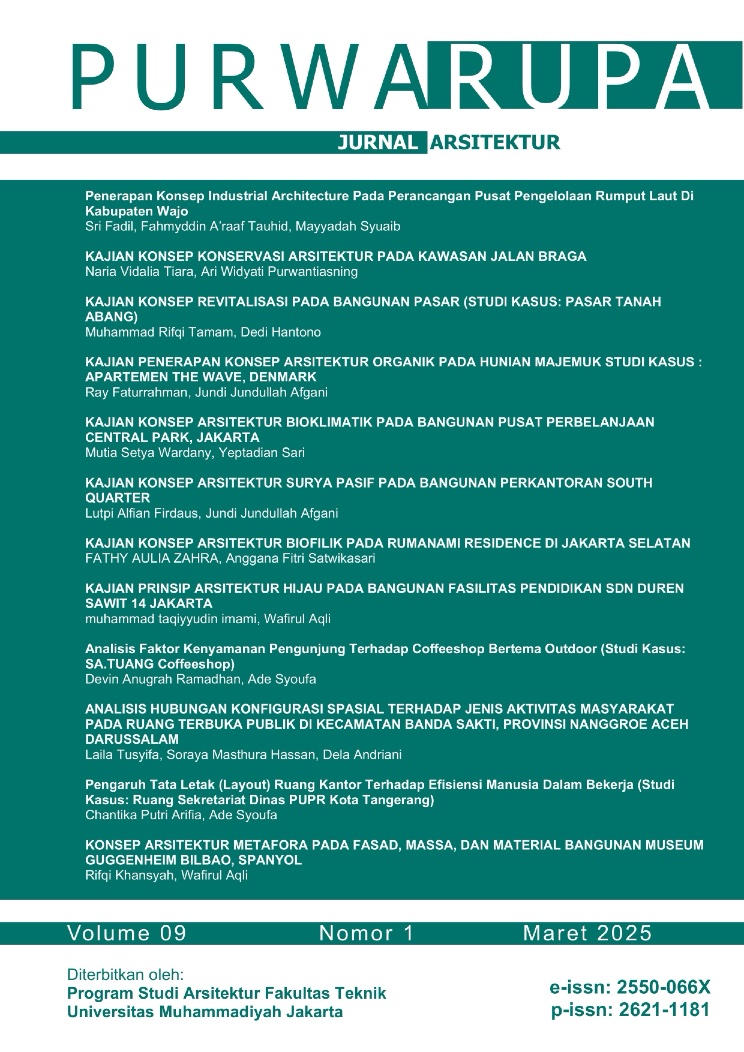KAJIAN KONSEP ARSITEKTUR BIOKLIMATIK PADA BANGUNAN PUSAT PERBELANJAAN CENTRAL PARK, JAKARTA
Abstract
Iklim tropis di Indonesia, ditandai dengan kondisi suhu yang tinggi, kelembapan, dan curah hujan yang bervariasi, menjadi semakin kompleks dalam menghadapi perubahan suhu yang ekstrem. Berdasarkan hasil analisis dari 116 stasiun pengamatan BMKG, suhu udara rata-rata bulan Agustus 2023 adalah sebesar 26.7 °C. Normal suhu udara klimatologis untuk bulan Agustus 2023 periode 1991-2020 di Indonesia adalah sebesar 26.2 °C (dalam kisaran normal 20.1 °C - 28.6 c). Penelitian ini mempelajari konsep dasar arsitektur bioklimatik, meneliti bagaimana strategi desain pasif, ventilasi alami, teknik peneduh, dan penggabungan tanaman hijau dapat diintegrasikan dengan baik ke beberapa bagian mall. dengan tujuan untuk mengidentifikasi dan memahami penerapan konsep arsitektur bioklimatik yang dapat di terapkan pada bangunan pusat perbelanjaan. Metode yang dipergunakan dalam tahap proses penelitian ini dengan menggunakan metode deskriptif kualitatif, mengumpulkan dan menganalisis hasil data-data sekunder dan primer yang telah di dapat setelah melakukan survei ke lokasi studi kasus yakni pada bangunan Central Park yang berada di pusat kota yakni wilayah Kota Jakarta. Berdasarkan hasil analisis yang telah di bahas oleh penulis bawa Central Park Mall telah menerapkan 6 poin prinsip arsitektur bioklimatik yang telah di paparkan oleh Ken Yeang , hal tersebut menjadi nilai positif karena Jakarta merupakan salah satu pusat jantung kota yang tingkat kualitas udara sangat buruk karena terkontaminasi oleh banyaknya asap kendaraan. Kata Kunci: Arsitektur, Bioklimatik, Perubahan Iklim, Pusat Perbelanjaan, Modern ABSTRACT. Indonesia's tropical climate, characterized by conditions of high temperature, humidity and variable rainfall, becomes increasingly complex in the face of extreme temperature changes. This research studies the basic concepts of bioclimatic architecture, examining how passive design strategies, natural ventilation, shading techniques, and the incorporation of green plants can be well integrated into several parts of the mall. with the aim of identifying and understanding the application of bioclimatic architectural concepts that can be applied to shopping center buildings. The method used in this stage of the research process uses a qualitative descriptive method, collecting and analyzing the results of secondary and primary data that have been obtained after conducting a survey at the case study location, namely the Central Park building in the city center, namely the Jakarta City area. Based on the results of the analysis discussed by the author, Central Park Mall has implemented 7 of the 8 points of the principles of bioclimatic architecture which have been explained by Ken Yeang in the form of Relationship to Landscape, Design on Walls, Use of Balconies, Passive Visualization Tools, Determining Building Orientation, Placement Window Openings, Transitional Spaces, and Heat Insulation on the Floor. This is a positive value because Jakarta is one of the heart of the city where the air quality level is very bad because it is contaminated by a lot of vehicle fumes. Keywords: Architecture, Bioclimatic, Climate Change, Shopping Center, ModernReferences
Bloom, N., & Reenen, J. Van. (2013). 済無No Title No Title No Title. NBER Working Papers, 9, 89.
Megawati, L. A., & Akromusyuhada, A. (2019). Pendekatan Arsitektur Bioklimatik Pada Konsep Bangunan Sekolah Hemat Energy. Arsitektura, 17(1), 77–86.
Walidin, W., Saifullah, & Tabrani, Z. A. (2016). Metodologi Penelitian Kualitatif & Grounded Theory. Banda Aceh: FTK Ar-Raniry Press.
Waskita, S. F. (2009). Shooping Center di Yogyakarta. Thesis. Universitas Atma Jaya Yogyakarta.
Yeang, K. (1994). Bioclimatic Skyscrapers. London: Artemis.
Downloads
Published
How to Cite
Issue
Section
License
COPYRIGHT POLICY
The author(s) of an article published in the Jurnal Teknologi retains ownership of the intellectual property rights in work (s).
PUBLISHING RIGHTS
The author(s) of an article published in the Jurnal Teknologi have unrestricted publication rights. The authors give the Jurnal Teknologi the right to publish the article and designate the Faculty of Engineering Universitas Muhammadiyah Jakarta Publishing as the original publisher of the article.
LICENSING POLICY
Journal of Mechanical Engineering and Sciences is an open-access journal that follows the Creative Commons Non-Commercial 4.0 International License (CC BY-NC 4.0), which states that:

Under this license, the reusers must give appropriate credit, provide a link to the license, and indicate if changes were made. Users may do so in any reasonable manner, but not in any way that suggests the licensor endorses users or their use.
Please take the time to read the whole license agreement (https://creativecommons.org/licenses/by-nc/4.0/). As long as reusers follow the license conditions, the owner cannot withdraw these freedoms. The following components are included under this license:
 Attribution: Users must provide appropriate attribution, including a link to the license, and indicate whether or not they made any modifications. Users are free to do so reasonably, but not in a manner that indicates the licensee approves of their usage.
Attribution: Users must provide appropriate attribution, including a link to the license, and indicate whether or not they made any modifications. Users are free to do so reasonably, but not in a manner that indicates the licensee approves of their usage.
 NonCommercial: Users may not use the material for commercial purposes.
NonCommercial: Users may not use the material for commercial purposes.

